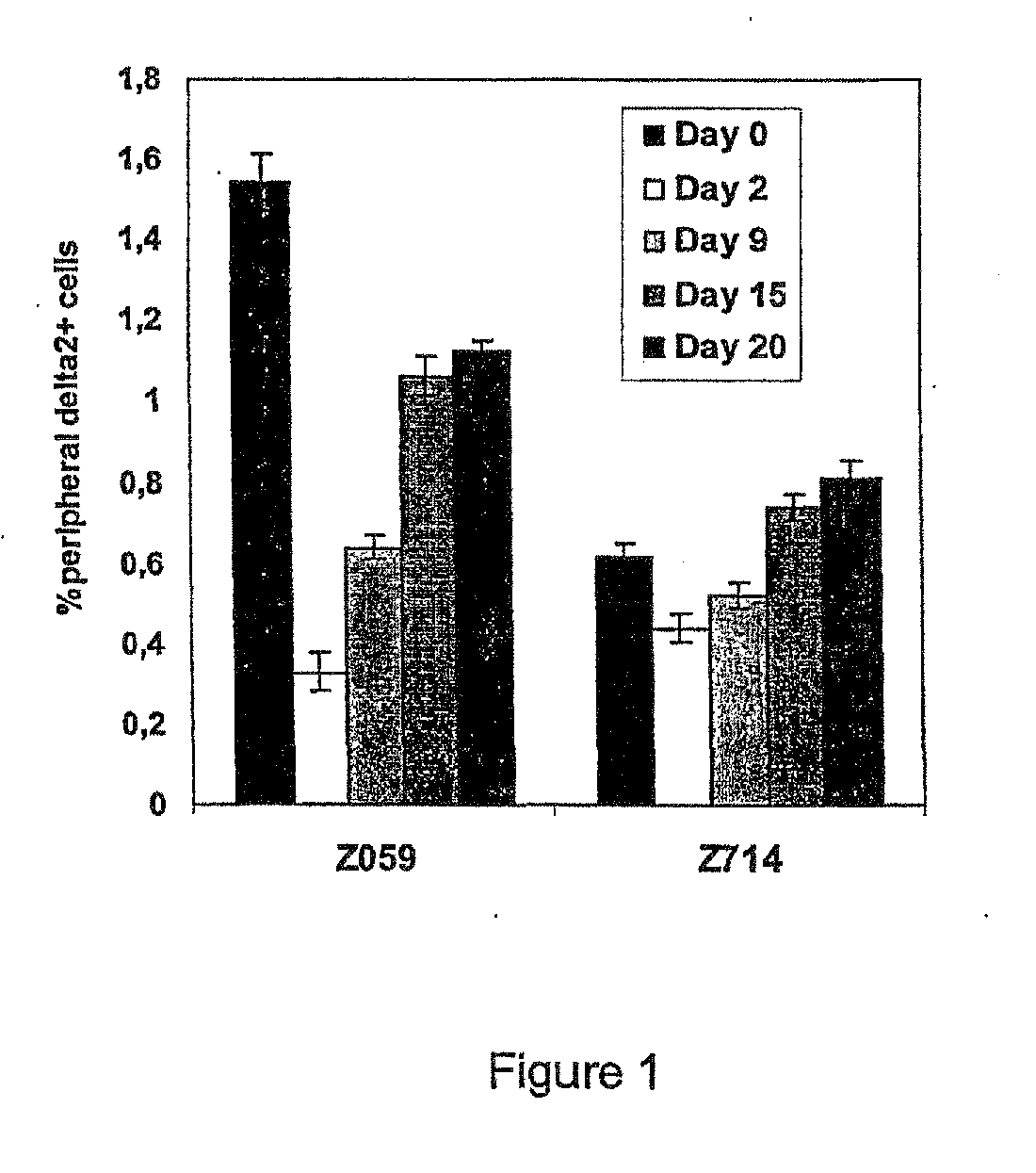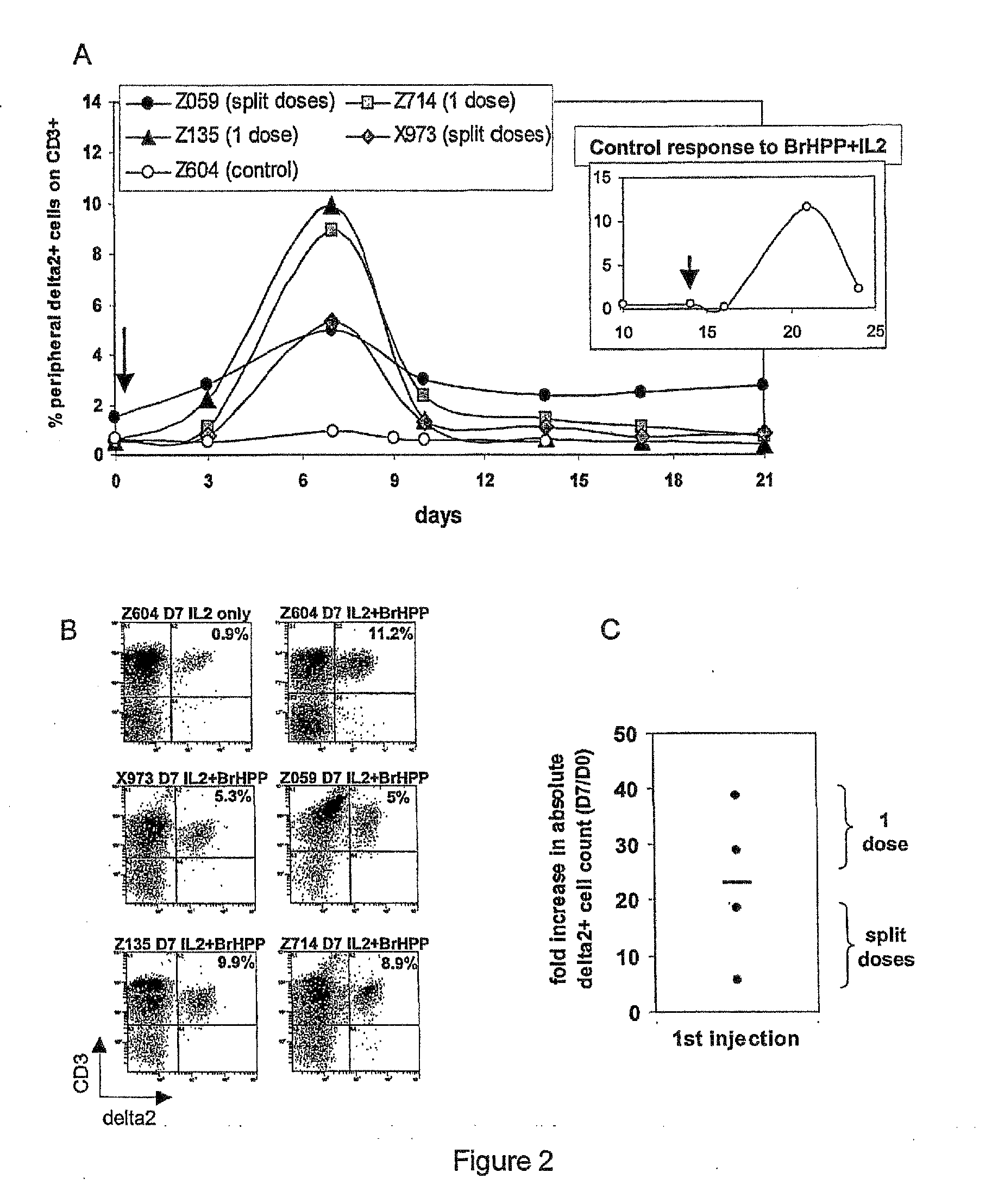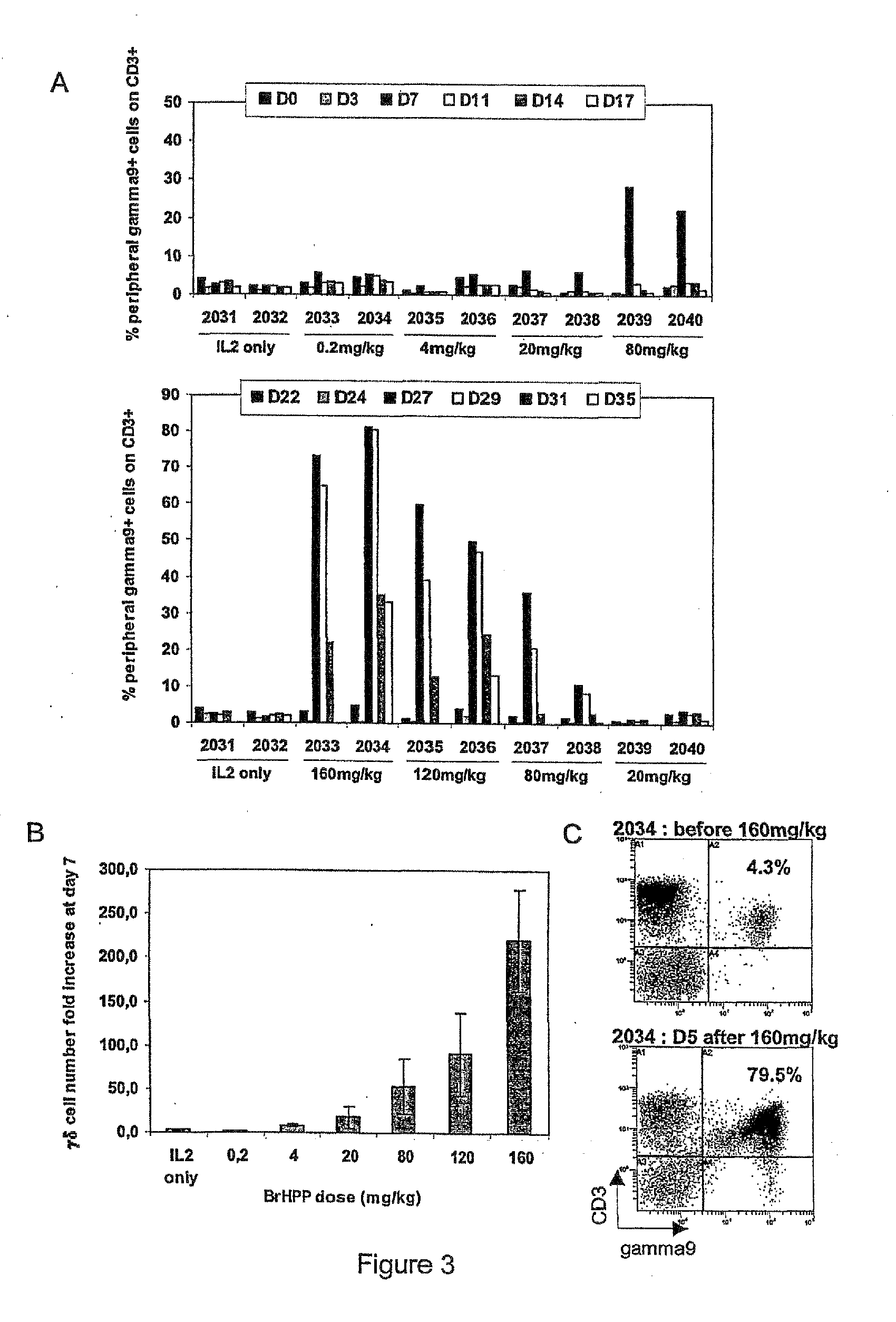Compositions and Methods for Regulating an Immune Response in a Subject
a technology of immune response and composition, applied in the field of compositions and methods for regulating an immune response in a subject, can solve the problems of inability to produce substantial stimulation of v9/v2 t cell activity, no method or treatment regimen has been proposed for the use of phosphoantigens with high specific activity in vivo, and achieves the effects of increasing biological activity, reducing the mass of solid tumors, and high potency
- Summary
- Abstract
- Description
- Claims
- Application Information
AI Technical Summary
Problems solved by technology
Method used
Image
Examples
example 1
Synthesis of BRHPP
[0455]All glassware and equipment were dried for several hours prior to use. Unless otherwise stated, the reagents and starting material were from Fluka. Trisodium (R,S)-3-(bromomethyl)-3-butanol-1-yl-diphosphate (BrHPP) was produced as white amorphous powder by the following procedure. Tosyl chloride (4.8 g, 25 mmol) and 4-(N,N-dimethylamino-) pyridine (3.4 g, 27.5 mmol; Aldrich) were mixed under magnetic stirring with 90 ml of anhydrous dichloromethane in a 250-ml three-necked flask cooled in an ice bath. A solution of 3-methyl-3-butene-1-ol (2.2 g, 25 mmol) in about 10 ml of anhydrous dichloromethane was then slowly introduced with a syringe through a septum in the flask, and the ice bath was then removed. The reaction was monitored by silica gel TLC (pentane / ethyl acetate, 85:15 (v / v)). After 2 h with constant stirring, the mixture was precipitated by dilution into 1 liter of hexane and filtered, and the filtrate was concentrated under reduced pressure. This fi...
example 2
Synthesis of HDMAPP Using the Method of HECHT et al (2002)
(E)-4-Chloro-2-methylbut-2-en-1-ol
[0458]TiCl4 (285 mg, 1.5 mmol, 164.5 μL) is dissolved in 3 mL of dry CH2CL2 under N2. The solution is cooled to −80 to −90 C, and a solution of 84 mg of commercially available 2-methyl-2-cinyloxirane (98.2 μL, 1 mmol) in 0.4 mL of CH2CL2 is added in dropes with stirring. After 90 min. the reaction mixture is quenched by adding 5 mL of 1N HCl. After warming to room temperature, the phases are separated and the aqueous layer is extracted four times with 20 mL of diethyl ether. The combined organic phases are dried over MgSO4. Evaporation of the solvent and purification by flash chromatography (pentanes / diethyl ether 1:1 v / v) affords 93 mg of pure product.
(E)-1-Hydroxy-2-methylbut-2-enyl 4-diphosphate from (E)-4-Chloro-2-methylbut-2-en-1-ol
[0459]A solution containing 227 mg (0.25 mmol) of tris (tetra-n-butylammonium) hydrogen pyrophosphate in 300 μL of MeCN is added slowly at room temperature to...
example 3
BRHPP Non-GLP Studies
3.1. Material and Methods
3.1.1. Animals
[0460]Group 1: 5 purpose bred healthy male cynomolgus monkeys (M. fascicularis), supplied by C.R.P. Le Vallon, Ferney S.E., Mahebourg, Mauritius. At the beginning of the study, body weights range from 3.7 to 4.6 kg.[0461]Group 2: 10 purpose bred healthy cynomolgus monkeys (5 males and 5 females), supplied by C.R.P. Le Vallon. At the beginning of the study, body weights range from 1.8 to 3.5 kg and ages from 2 to 3 years.
[0462]Husbandry conditions conformed to the European requirements, comprising monitored temperature, humidity, air change and lighting cycle. Group 1 animals were housed in Biomatech (Chasse sur Rhone, France), and group 2 animals were housed in MDS, (Les Oncins, France).
[0463]All experiments were subjected to local ethical committee before processing.
3.1.2. Phosphoantigens
[0464]The synthesis and characterization of trisodium (R,S)-3-(bromomethyl)-3-butanol-1-yl-diphosphate BrHPP has been described previousl...
PUM
| Property | Measurement | Unit |
|---|---|---|
| time | aaaaa | aaaaa |
| time | aaaaa | aaaaa |
| concentrations | aaaaa | aaaaa |
Abstract
Description
Claims
Application Information
 Login to View More
Login to View More - R&D
- Intellectual Property
- Life Sciences
- Materials
- Tech Scout
- Unparalleled Data Quality
- Higher Quality Content
- 60% Fewer Hallucinations
Browse by: Latest US Patents, China's latest patents, Technical Efficacy Thesaurus, Application Domain, Technology Topic, Popular Technical Reports.
© 2025 PatSnap. All rights reserved.Legal|Privacy policy|Modern Slavery Act Transparency Statement|Sitemap|About US| Contact US: help@patsnap.com



